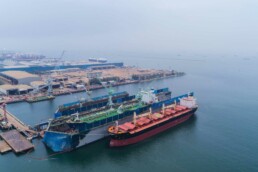Omnichannel Fulfillment - The Falcon Difference
Omnichannel Fulfillment – The Falcon Difference
What is omnichannel fulfillment? The simple answer is that omnichannel fulfillment is a streamlined process of picking, packing, and shipping orders across multiple sales channels. The more complicated reality is that it is an integrated, collaborative network of logistics, technology platforms, and order fulfillment options that create a cohesive purchasing experience for consumers, regardless of where they bought their item. As consumers’ expectations adapt to greater freedom and flexibility in the shopping journey, e-commerce brands must also adapt. This article will share some basic information regarding omnichannel fulfillment, the benefits and challenges of implementing this strategy, and how partnering with a 3PL can help.
Benefits of Omnichannel Fulfillment
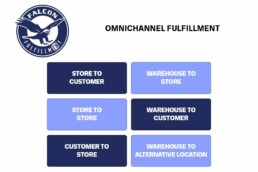
More Accurate Data
Data is only good if it is accurate. Many e-commerce companies still have multichannel sales with siloed data. Omnichannel fulfillment eliminates the data silos by creating a single point of truth concerning inventory management. All SKUs funnel into a singular platform that allows business owners to make crucial decisions on inventory, sales, and marketing efforts. Forecasting becomes clearer and targets high-performing sales channels and ones that might need revamping. Better data means better decisions.
Reach More Customers
Omnichannel fulfillment allows brands to tap into new sales channels and reach new customers. By offering multiple fulfillment options like; ship to the customer, BOPIS, curbside, brick-and-mortar, and even locker pick up, customers have more access to buying your product. When you have more fulfillment options, you have more sales opportunities.
Greater Customer Satisfaction
No matter where a consumer decides to buy your product, providing them multiple ways to purchase and a seamless brand experience increases satisfaction. Leveraging omnichannel fulfillment will get products into consumers’ hands faster than a siloed multichannel approach. The reason is that although it might take 2-3 days to ship directly from the warehouse, a local store might have stock, and a BOPIS option can be made available. Customers who need it today will love the fact they can do the driving for your brand if that means they get that last-minute gift in time!
Complications with Omnichannel Fulfillment

Integrated Inventory Management
One of the main essentials to omnichannel fulfillment success is integrating all the technology systems that track and collate sales data. For some brands, they must start all over, adding new SKUs to a single inventory management system. For others, it requires a nuanced approach where systems talk to each other in real-time. If pre-built technology integrations are available, this isn’t difficult. However, the proprietary nature of inventory systems will often require an overhaul or a top-notch developer to code the API keys. Getting all the technology systems to communicate is crucial to ensure a single SKU for each item. This can be a significant undertaking if your business has multichannel fulfillment with different SKUs.
Difficult to Manage Infrastructure and Fulfillment Strategy
Fulfilling orders from multiple channels to multiple endpoints is complex. It requires expert knowledge in logistics, warehousing, inventory management, and transportation. Flexible staffing is needed, especially during seasonal sales periods. Investments in fulfillment warehouses, equipment, and fulfillment technology will become necessary as you scale. Partnering with a 3PL is an excellent way to outsource the difficulty and expense of offering omnichannel fulfillment.
The Falcon Difference in Omnichannel Fulfillment
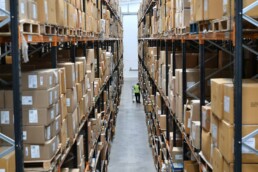

 Automated Inventory Management
Automated Inventory Management
Falcon Fulfillment uses an automated inventory management system that allows your brand to have the most accurate data for your inventory. It is simple to manage high-volume requirements. We utilize advanced barcoding technology to track inventory and guarantee the right product is shipped and received every time. “Four Ways a 3PL Can Help with Outsourcing Inventory Management.”
Personalized Approach
At Falcon, we don’t believe in a one-size-fits-all approach. Instead, we recognize that each brand is unique, and the omnichannel fulfillment strategy will need to accommodate for the differences. Therefore, we are proud to offer a level of customized service our competitors struggle to match. Specifically, every client has a dedicated Account Manager who works closely with them. As a result, this has allowed Falcon to understand their client’s individual needs and build a process to help meet those requests. By taking this personalized approach, we ensure that our clients receive the tailored support they need to succeed in their omnichannel fulfillment endeavors.
Eco-friendly Custom Packaging & Kitting Services
If you have been fulfilling in-house and want to jump to an omnichannel fulfillment strategy without losing the personal touch, Falcon can help. Specifically, Falcon offers on-site branding and packaging solutions to ensure a seamless brand experience across all sales channels. For instance, we can provide perfect-sized packaging, printed inserts, and even detailed personalization. As a result, you can maintain a strong brand identity while expanding your reach through multiple channels.
Beginner’s Guide to Third-Party Logistics (3PL)
The world of e-commerce is always changing, therefore understanding the roll of Third-Party Logistics is integral to keeping up. In light of this our beginner’s guide to third-party logistics (3PL) will delve into the essential aspects, offering insights into fulfillment services, warehousing, and much more.
Read More…
Omnichannel fulfillment offers exceptional benefits to e-commerce companies willing to adopt the strategy. Therefore, doing it well requires expert knowledge and implementation.
Let the experts at Falcon Fulfillment walk you through the omnichannel fulfillment possibilities for your brand today.
Let’s Talk!
Politics' Impact on Supply Chains Unveiled
Navigating 2024: Politics’ Impact on Supply Chains Unveiled
The world of supply chains is evolving, and in this pivotal year, politics emerges as a dominant force shaping the landscape. In a recent survey by the Reshoring Institute, the unexpected revelation was that politics stood out as the key influencer in 2024. As we delve into the intricacies, it’s clear that political decisions will echo across various aspects of our supply chain endeavors.
Unveiling the Impact: Politics Takes Center Stage in Supply Chain Predictions

In supply chain predictions, politics emerges as a pivotal player, garnering attention from a staggering 70% of respondents who highlight its significance. Unlike bygone eras where politics served as a mere backdrop, today it commands the spotlight, poised to influence a multitude of supply chain decisions.
The Political Landscape of 2024: Navigating Potential Scenarios
Digging into the political landscape of 2024 reveals a tapestry of potential scenarios that could shape the supply chain trajectory. Whether Trump secures victory or a Biden re-election unfolds, distinct shifts are anticipated, each carrying its own implications for the supply chain ecosystem.
Trump’s Triumph: A Shift to Domestic Focus
In the event of Trump’s victory, expectations revolve around a pronounced shift towards a domestic focus. Anticipated policies emphasize closing borders and reducing U.S. involvement abroad, potentially driving a surge in domestic sourcing and manufacturing. However, the persistent challenge of labor shortages looms large, casting shadows on the manufacturing landscape.
Biden’s Re-Election: Boosting Domestic Industries
Conversely, a Biden re-election forecasts increased investment in domestic industries, strategically positioning American products for enhanced global competitiveness. Global partnerships are poised to flourish under this administration. While reshoring gains momentum under both leaders, the specter of labor shortages continues to cast its shadow over the manufacturing sector.
U.S. Trade Relationships: Spotlight on Mexico and Beyond
As the U.S. navigates its intricate web of trade relationships, the spotlight remains firmly on Mexico, especially with the USMCA in play. Infrastructure investments in the border region, encompassing roads, bridges, and customs enforcement, promise to reshape trade dynamics. Simultaneously, China remains a focal point, with the trade war persisting and new sanctions, particularly on technology and electronics imports.
Mexico Dominates: Shifting Trading Partnerships
Having surpassed China as the leading U.S. trading partner in 2023, Mexico takes center stage. Moreover, amidst ongoing immigration debates, the trend of manufacturing steadily migrating from China to Mexico gains prominence. Additionally, regulatory pressure points, ranging from environmental concerns to recycling and carbon footprint reduction, continue to reverberate across every link in the supply chain. Therefore, as a key player in North American trade, developments in Mexico have ripple effects across interconnected supply chains. Ultimately, by staying abreast of the evolving dynamics, we can work collaboratively to enact policies and practices that balance economic, social, and environmental priorities on both sides of the border. Through strategic partnership, we can strengthen cross-border cooperation at this pivotal juncture.
AI Adoption and Politics: Navigating Regulatory Uncertainties
The continued adoption of AI in supply chain information introduces a nuanced intersection with politics, raising pertinent questions about impending regulations. Intriguingly, neither Trump nor Biden demonstrate a comprehensive understanding of AI’s intricacies, adding an additional layer of uncertainty to its future within the supply chain landscape.
Politics Impact on Supply Chains: Adaptation Becomes Imperative
As the political drumbeat reverberates through this supply chain year, adaptation emerges as an imperative. Stay tuned as we unravel the unfolding dynamics, where politics intricately intertwines with third-party logistics (3PL), fulfillment services, and the entire spectrum of supply chain management.
Beginner’s Guide to Third-Party Logistics (3PL)
The world of e-commerce is always changing, therefore understanding the roll of Third-Party Logistics is integral to keeping up. In light of this our beginner’s guide to third-party logistics (3PL) will delve into the essential aspects, offering insights into fulfillment services, warehousing, and much more.
Read More…
Within this dynamic political year, Falcon Fulfillment stands ready to help navigate the complexities, offering scalable fulfillment solutions meticulously tailored to meet the demands of 2024. Furthermore, stay informed and adaptive as we explore uncharted territories where politics and supply chains converge. However, even during uncertain times, our customized services aim to provide stability. Therefore, by working closely together, we can build resilient supply chains capable of thriving throughout this transformative period and beyond. Ultimately, our flexible and responsive approach means we’re prepared for the road ahead.
Regardless of which way you swing, Falcon Fulfillment is here to help keep your business tuned into the latest developments and stay adept at avoiding logistical hurdles.
Let’s Talk!
Import Growth Amid Red Sea Delays: Retailer Strategies
Navigating Import Growth Amid Red Sea Delays: Retailer Strategies
In global commerce, the delicate balance between geopolitical events and supply chain dynamics often dictates the trajectory of trade. Despite the challenges posed by Red Sea delays, U.S. retailers express confidence in import growth throughout 2024. However, beneath this optimism lies a keen awareness of rising costs and the imperative for strategic initiatives to navigate the evolving landscape of international trade.
The recently unveiled Global Port Tracker report by the National Retail Federation (NRF) and Hackett Associates illuminates the prevailing sentiment among retailers, projecting a substantial 20.4% year-over-year increase in February. This surge in import volumes is a testament to robust demand, showcasing the adaptability of retailers in confronting disruptions along critical shipping routes.
Approximately 12% of U.S.-bound cargo traverses the Suez Canal, a vital conduit for global trade. Recent incidents, including terrorist attacks in the Red Sea, have raised concerns about the reliability of the supply chain. Despite these challenges, industry stakeholders are proactively implementing strategies to minimize the impact on operations.
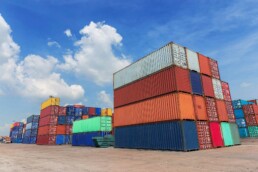
Mitigation Strategies and Adaptation
Carriers are deploying a pivotal strategy by utilizing surplus capacity to circumvent disruptions. This involves redirecting voyages around the Cape of Good Hope or to alternative ports, demonstrating a commitment to maintaining supply chain continuity amid Red Sea delays.
Furthermore, retailers are advocating for earlier shipments and exploring alternative transportation modes, such as air cargo, for time-sensitive goods. Collaborating closely with overseas suppliers and logistics partners, retailers aim to optimize inventory management and ensure the timely delivery of merchandise despite the challenges posed by Red Sea delays.
Navigating Cost Concerns
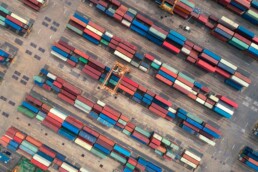
While import growth remains promising, concerns loom over the escalating costs associated with supply chain disruptions. Retailers are bracing for potential price increases and surcharges, especially as they enter into new contract negotiations with carriers. The uncertainty surrounding the duration of the Red Sea crisis compounds these concerns, prompting calls for government intervention to address systemic challenges.
In testimony before regulatory bodies, industry representatives emphasize the need for transparency and accountability in pricing mechanisms. Sarah Gilmore, Director of Supply Chain Policy at the Retail Industry Leaders Association (RILA), underscores the correlation between surcharges and tangible costs, advocating for a balanced approach to pricing adjustments amid Red Sea delays.
Strategies for Building Resilient Supply Chains
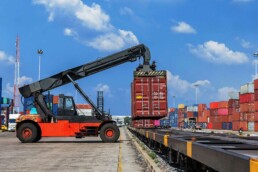
As retailers navigate the complexities of global trade amid Red Sea delays, a proactive approach to supply chain management is paramount. Incorporating the keyphrase “Import Growth Red Sea Delays” into the narrative, businesses can enhance visibility and agility within their operations, fostering resilience and adaptability in the face of disruptions.
- Supply Chain Optimization: Implementing robust inventory management systems and demand forecasting tools is crucial for optimizing resource allocation amid Red Sea delays.
- Risk Mitigation: Diversifying sourcing strategies and establishing contingency plans can help mitigate the impact of geopolitical events and natural disasters, including Red Sea delays.
- Collaborative Partnerships: Strengthening collaboration with logistics providers and industry stakeholders becomes even more crucial during times of disruption, contributing to the overall resilience of supply chains amid Red Sea delays.
Beginner’s Guide to Third-Party Logistics (3PL)
The world of e-commerce is always changing, therefore understanding the roll of Third-Party Logistics is integral to keeping up. In light of this our beginner’s guide to third-party logistics (3PL) will delve into the essential aspects, offering insights into fulfillment services, warehousing, and much more.
Read More…
While challenges persist in the form of Red Sea delays and geopolitical uncertainties, retailers remain steadfast in their pursuit of import growth and operational excellence. By embracing innovation and strategic partnerships, businesses can navigate turbulent waters and emerge stronger in an ever-evolving global marketplace. As the industry continues to evolve, proactive adaptation and a commitment to supply chain resilience, especially amid Red Sea delays, will be instrumental in shaping the future of international trade.
Falcon Fulfillment can help tailor solutions to help companies navigate the Red Sea shipping delays. Ensuring a reliable path for import growth despite disruptions.
Let’s Talk!
Brace for Major 2024 Shipping Rate Increases: How to Offset the Impact
GRI rate increase for 2024
Demand forecasting involves predicting future sales data using historical data, market research, and other influential factors. It allows businesses to create more precise sales predictions. There are many types and methods of creating a demand forecast for your business. Determining which will work best for your e-commerce business is challenging, but it is well worth the investment. Creating a demand forecast is not 100% accurate but will inform better business decisions, strategy, and cash flow. Let’s get into the basics of demand forecasting; the types, benefits, and steps to create one.
Quantifying the True Impact of 2024 Shipping Rate Increases
FedEx and UPS announced general rate increases of 5.9%, causing many businesses to budget for shipping cost increases at or below that threshold. But make no mistake: virtually no company will actually see such a small hike.
Without advanced predictive data science, it’s nearly impossible to accurately quantify the full impact of GRIs and other pricing changes implemented by carriers. Models must account for all of the following factors on a per-package basis:
- Base rate changes
- Dimensional weight pricing adjustments
- Surcharge increases
- Fuel surcharge modifications
- Residential delivery fees
- Additional handling charges
- Other factors
By leveraging sophisticated simulation and modeling, logistics experts can uncover the true rate hike percentage that shippers will endure. This analysis takes into account your specific shipping patterns, volumes, package characteristics, and more.
On average, small and medium businesses will experience the following increases in 2024:
- UPS: 7.72%
- FedEx: 8.17%
That’s nearly a full 3 percentage points higher than the announced GRIs. Companies moving high volumes of large, heavy packages and requiring additional services like residential delivery will see even greater rate impacts.
Now that we’ve established the true cost increase, let’s explore some logistics strategies to help offset this hit to your shipping budget and profit margins…
5 Shipping Logistics Strategies to Combat 2024 Rate Increases
Secure a multi-year UPS or FedEx contract with negotiated rates
Carriers are hungry for new business as volumes dip. Therefore, leverage this to negotiate a competitive contract through 2024 with built-in caps on annual rate increases.
Diversify across multiple carriers
Additionally, add regional parcel carriers like OnTrac or DHL to your shipping portfolio. This spreads risk and makes you less beholden to the whims of a single provider.
Optimize packaging to avoid dimensional weight charges
Furthermore, evaluate all package sizes and shapes to right-size boxes. Ultimately, this reduces costly dim weight fees that spike along with base rate hikes.
Invest in shipping software for greater visibility and control
Moreover, invest in shipping software for greater visibility and control since cloud-based shipping solutions enable dynamic carrier selection, customized business rules, and comprehensive analytics to unlock savings.
Work with a third-party logistics (3PL) partner
Finally, work with a third-party logistics (3PL) partner to let the experts handle everything from negotiating contracts to optimizing your supply chain. In summary, leverage their scale and expertise for lower shipping costs.
The Bottom Line on Shipping Rate Increases 2024
Be prepared for the real impact of 2024 FedEx and UPS rate increases by accurately modeling your cost exposure. Then fight back against diminishing margins with the help of advanced logistics technologies, strategic partnerships, and sheer shipping volume muscle.
Beginner’s Guide to Third-Party Logistics (3PL)
The world of e-commerce is always changing, therefore understanding the roll of Third-Party Logistics is integral to keeping up. In light of this our beginner’s guide to third-party logistics (3PL) will delve into the essential aspects, offering insights into fulfillment services, warehousing, and much more.
Read More…
With the right data, relationships and infrastructure, you can avoid merely absorbing ever-increasing rates as the “cost of doing business”. Therefore, take control and let your supply chain drive cost containment and competitive advantage. Specifically, by leveraging data and analytics, you can gain visibility into rates and identify opportunities to optimize costs. Additionally, by collaborating closely with carriers and other supply chain partners, you can align incentives and develop win-win solutions. Ultimately, with the proper foundation in place, you can transform your supply chain into a source of strategic value rather than simply a cost center.
Falcon Fulfillment can negotiate better rates and help control these costs. Contact us today to see what we can do for your business.
Let’s Talk!
Employee Engagement: The Keys to Employee Retention
Employee Engagement: The Keys to Employee Retention
Employee satisfaction is a critical aspect of a thriving supply chain, and understanding the factors that contribute to retention success is paramount. According to the 2023 Employee Satisfaction Survey conducted by Butterfly.ai and Supply Chain Management Review, 77% of employee turnover can be attributed to poor management. In this article, we delve into the key elements that unlock employee engagement and foster retention success in the supply chain industry.
The Impact of Poor Management
Toxic work environments, lack of trust, limited growth opportunities, and concerns about compensation are major contributors to employee turnover. Simon Rakosi, CEO of Butterfly.ai, emphasizes the urgency for companies to invest in effective management training and support. Certainly addressing these issues is crucial for retaining the invaluable frontline workforce.

Investing in Career Development
The survey reveals that 30% of respondents are dissatisfied with the investment their organizations make in their training. This key to employee retention underscores the importance of companies focusing on career development to retain talent. Despite this, 71% feel they are given opportunities to apply their expertise, and 47% believe in available career advancement opportunities.
Engaging Workplace Environment
Employee engagement is high, with 90% giving their best effort, and 84% feeling deeply involved in their work. Rakosi suggests that addressing emotional facets such as feeling valued, respected, and fostering positive relationships with managers is key to retention. Additionally, 59% are satisfied with their overall compensation.
Remote Work Preferences
One of the more recent keys to employee retention is preferences for remote and hybrid work environments. The survey indicates that 57% prefer a hybrid work setup, while 22% favor remote work, and 20% prefer onsite full-time. Even so, balancing remote work options can impact employee connection, as only 28% of exclusively remote employees feel strongly connected to their organizations.
Suggestions for Improvement
Respondents provided feedback on enhancing the workplace, focusing on areas such as healthcare, communication, resource allocation, wages, and fear elimination. Relationship management is highlighted, with suggestions for team-building activities, one-on-one check-ins, and training sessions on decision-making.
Positive Aspects of the Workplace
Despite challenges, positive comments highlight the ability to apply new skills, flexible time-off policies, continuous learning opportunities, a family-oriented atmosphere, and social and environmental impact. Recognizing and celebrating hard work through town-hall meetings and shift huddles is also emphasized.
Keys to Employee Retention – Building a Preferred Workplace
To enhance engagement and organizational success, strategies include fostering a positive work environment, offering continuous learning opportunities, and recognizing achievements. Generally, by addressing these factors, companies can cultivate a dynamically engaged workforce, leading to increased efficiency and organizational growth.
Beginner’s Guide to Third-Party Logistics (3PL)
The world of e-commerce is always changing, therefore understanding the roll of Third-Party Logistics is integral to keeping up. In light of this our beginner’s guide to third-party logistics (3PL) will delve into the essential aspects, offering insights into fulfillment services, warehousing, and much more.
Read More…
Unlocking employee engagement and achieving retention success requires a holistic approach that addresses issues ranging from management training to creating a positive work environment. Undoubtedly by implementing these strategies, organizations in the supply chain industry can build a workplace where employees thrive and contribute to long-term success.
Contact us to learn more about our services.
Let’s Talk!
Top 10 E-commerce Trends for 2024
Top 10 E-commerce Trends for 2024: Insights, Predictions & Future Projections
As e-commerce continues to grow, staying ahead of trends is pivotal for businesses. With 2024 on the horizon, understanding the forthcoming changes and anticipated shifts within the digital marketplace becomes paramount. With this in mind, here are the top 10 e-commerce trends for 2024 that are expected to reshape the landscape in the year ahead.
1. Real-Time Employee Feedback

The adage “a happy employee equals a happy customer” has never been more relevant than in today’s e-commerce environment. Implementing robust systems for real-time employee feedback is not only about acknowledging and addressing potential issues promptly but also about cultivating a work culture that fosters transparency and continuous improvement.
Creating an environment where feedback is encouraged and acted upon can significantly impact operational efficiency and customer satisfaction. By leveraging intuitive survey tools and platforms, businesses gain insights into employee sentiments, identify pain points, and swiftly address concerns before they escalate.
Moreover, the cascading effect of an empowered workforce is evident in customer interactions, reflecting positively on the brand’s image and customer loyalty.
2. Augmented Reality
Augmented Reality (AR) has transcended its nascent stage, metamorphosing into a game-changer for e-commerce. Addressing the longstanding uncertainty associated with online shopping, AR bridges the gap between virtual and physical experiences.
Imagine browsing through an online furniture store and using AR to visualize how a sofa would look in your living room. This immersive technology empowers consumers to make informed purchase decisions by virtually trying products before buying, mitigating the risk of post-purchase disappointment.
Despite its potential, the widespread adoption of AR in e-commerce necessitates significant investment in technological infrastructure. As businesses strive to integrate AR seamlessly, consumers can anticipate a future where the boundaries between online and offline shopping experiences blur.
3. Voice Shopping
A newer e-commerce trend for 2024 to consider is voice shopping. Voice recognition technology has gained substantial traction, transforming the e-commerce landscape by providing a hands-free shopping experience. The advent of digital voice assistants has propelled voice shopping into the mainstream, offering unparalleled convenience and accessibility to consumers.
Enabling users to browse, search, and make purchases through voice commands, this technology streamlines the purchasing journey. However, its implementation presents challenges, particularly in accurately interpreting diverse accents and speech patterns, necessitating continuous refinements.
Businesses harnessing the potential of voice shopping stand poised to cater to a burgeoning demographic seeking frictionless and intuitive shopping experiences.
4. Chatbots
The proliferation of AI-driven chatbots has revolutionized customer support within the e-commerce sphere. These intelligent systems, operating round-the-clock, serve as the first line of interaction for consumers seeking information, guidance, or assistance.
Chatbots, leveraging machine learning algorithms, analyze customer queries, provide instant responses, and continuously learn from interactions to enhance their problem-solving abilities. Their seamless integration into websites and social platforms ensures swift issue resolution, thereby augmenting customer satisfaction.
However, while chatbots streamline support processes, human oversight remains imperative to intervene in complex scenarios requiring nuanced judgment or empathy. Balancing automation with human touch is the key to leveraging the full potential of chatbots in enhancing the customer experience.
5. Mobile Shopping
Mobile devices have evolved into indispensable tools, becoming the preferred medium for internet access. As the majority of online traffic emanates from mobile devices, ensuring a responsive and optimized mobile shopping experience has become non-negotiable for e-commerce businesses.
A user-friendly interface, intuitive navigation, and swift load times are pivotal in retaining mobile users’ engagement. Consequently, investing in responsive web design and mobile app development emerges as a strategic imperative.
While developing dedicated mobile applications might pose financial constraints for smaller enterprises, optimizing existing websites for mobile compatibility serves as a viable approach to cater to the mobile-centric consumer base.
6. Sustainability and Green Policies
The conscientious shift towards sustainability permeates every facet of modern life, and e-commerce is no exception. As businesses grapple with their environmental footprint, implementing eco-conscious practices across their operations becomes a cornerstone of their corporate responsibility.
From utilizing biodegradable or recyclable packaging to opting for carbon-neutral shipping methods, e-commerce enterprises are redefining their supply chains to minimize their ecological impact. Embracing sustainability isn’t merely a trend but a testament to a company’s commitment to environmental stewardship, resonating profoundly with eco-minded consumers.
As consumers increasingly prioritize ethically-sourced and eco-friendly products, brands that champion sustainability and integrate green policies into their business models are poised to foster deeper connections and trust with their audience.
7. Social Commerce
The symbiotic relationship between social media and e-commerce continues to flourish, catalyzing the evolution of social commerce. Platforms like Facebook, Instagram, and TikTok have evolved from mere marketing channels to comprehensive shopping destinations.
Integrating seamless shopping functionalities directly within social media platforms, businesses capitalize on reducing the purchasing journey’s friction. By amalgamating entertainment, engagement, and commerce in one space, social commerce emerges as a potent avenue for brands to interact with their audience more intimately.
Furthermore, as social media platforms augment their shopping features, businesses must adapt by curating captivating content and personalized experiences that resonate with their target demographics, transforming casual browsing into conversion opportunities.
8. Livestream Shopping
The resurgence of interactive shopping experiences through livestreams signifies a novel approach to merging entertainment and commerce. Blurring the lines between content consumption and retail, livestream shopping captivates audiences by offering real-time engagement and immediate purchasing options.
By leveraging livestreams for product demonstrations, reviews, and exclusive offers, businesses forge direct connections with their audience, fostering trust and authenticity. The convenience of accessing product information in real-time, supplemented by interactive discussions, enriches the shopping experience and expedites purchase decisions.
In essence, livestream shopping offers a dynamic platform for brands to showcase their products, engage with customers, and create a sense of community, transcending conventional transactional relationships. This e-commerce trend in 2024 could be a real game changer for the right product base.
9. Influencer Marketing
The paradigm shift in consumer behavior, favoring authenticity and relatability over traditional advertising, propels the ascendancy of influencer marketing in the e-commerce sphere. Consequently, influencers, wielding substantial influence over their followers, offer brands an avenue to connect with niche audiences authentically.
Moreover, collaborating with influencers facilitates organic endorsements, generating credible product recommendations that resonate with their engaged communities. Additionally, micro-influencers, with their smaller yet highly engaged followings, offer a cost-effective alternative for brands seeking hyper-targeted outreach. As a result, influencers continue to wield considerable sway in consumer purchase decisions.
Therefore, brands must forge genuine partnerships aligned with their values, ensuring authenticity and relevance. Ultimately, this approach fosters lasting connections with their target demographics.
10. Marketing Automation
The evolution of marketing automation technologies empowers businesses to streamline repetitive tasks, optimize workflows, and personalize customer interactions at scale. From automated email campaigns to behavior-driven retargeting, these tools enhance efficiency while delivering tailored experiences.
Given that, by harnessing data-driven insights and machine learning algorithms, marketing automation facilitates dynamic segmentation, delivering personalized content that resonates with individual preferences and behaviors. Additionally, it enables businesses to nurture leads effectively, guiding them through the sales funnel with precision and relevance.
Despite its efficacy, effective implementation of marketing automation necessitates a strategic approach. Consequently, balancing automation with a human touch is crucial to preserving authenticity and fostering genuine connections with customers.
Beginner’s Guide to Third-Party Logistics (3PL)
The world of e-commerce is always changing, understanding the roll of Third-Party Logistics is integral to keeping up. This beginner’s guide to third-party logistics (3PL) will delve into the essential aspects, offering insights into fulfillment services, warehousing, and much more.
Read More…
The evolving e-commerce trends of 2024—including real-time feedback, augmented reality, voice shopping, chatbots, mobile commerce, sustainability, social commerce, livestream shopping, influencer marketing, and marketing automation—are pivotal for businesses.
Adopting these trends strategically allows businesses to stay competitive, innovate, and connect with consumers in dynamic ways. In addition, by aligning strategies with these evolving trends, businesses navigate the e-commerce landscape, craft immersive experiences, and secure their place in the digital marketplace.
Connect with Falcon and learn how to embrace innovation, adapt to consumer demands, and shape the future of e-commerce by evolving with these transformative trends.
Let’s Talk!
Holiday Shipping Deadlines for 2023
Critical Holiday Shipping Deadlines for 2023
The 2023 holiday shopping season is fast approaching, which means e-commerce merchants need to prepare for the shipping rush to ensure customers receive their orders on time. Missing critical shipping deadlines with carriers like USPS, UPS, and FedEx can result in disappointed customers and lost revenue during your most important sales period.
Therefore, by familiarizing yourself with the 2023 shipping deadlines and developing efficient fulfillment and supply chain operations, you can avoid logistics headaches and provide exceptional delivery experiences. Moreover, this guide covers everything e-commerce retailers need to know about holiday shipping with leading carriers.

Key 2023 Holiday Shipping Deadlines for Major Carriers
To meet customer expectations and delivery commitments during the 2023 holiday season, retailers should follow these shipping deadlines from USPS, UPS, and FedEx.
Specifically, the key deadlines are:
- USPS Retail Ground: December 16
- USPS First Class: December 16
- USPS Priority Mail: December 16 (Hawaii and Alaska) and December 18 (elsewhere)
- USPS Priority Mail Express: December 20
Additionally, UPS deadlines include:
- UPS Ground Shipping: Refer to UPS website for region-specific deadlines
- UPS 3-Day Select: December 19
- UPS 2nd Day Air: December 20 or 21 with weekend delivery
- UPS Next Day Air: December 21 or 22 with weekend delivery
Finally, FedEx deadlines are:
- FedEx Home Delivery: Refer to FedEx website for region-specific deadlines
- FedEx Ground: December 13 for economy shipping
- FedEx Express Saver: December 19
- FedEx 2-Day Shipping: December 20
- FedEx Same-Day Service: December 22
These published deadlines account for expected holiday order volumes and transit days to ensure delivery by December 24-25. Therefore, retailers should be sure to check carrier websites for guidance on Alaska/Hawaii deadlines, as delivery timeframes may differ in those regions. Moreover, carriers may provide additional tips on their sites for shipping items to arrive before Christmas to remote areas. By referencing carrier holiday resources, merchants can set accurate delivery expectations with customers and avoid any unpleasant surprises. Following carrier guidance proactively will make for smooth sailing through peak season.
Accelerating Order Fulfillment
E-commerce order fulfillment accelerates dramatically during the holiday season, increasing pressure on fulfillment centers. Consequently, many retailers utilize third-party logistics (3PL) providers equipped with large warehouse networks and shipping infrastructure to meet fulfillment demand. Specifically, 3PLs offer e-commerce order fulfillment solutions like efficient distribution center design, advanced warehouse management systems (WMS), inventory and order tracking software, integrated shipping and delivery, and more. Thereby, by leveraging 3PL capabilities, e-commerce merchants can focus on sales while experts handle inventory, pick/pack, and shipping. In turn, fulfillment services enable retailers to flex capacity, making the holidays more manageable.
3PLs offer e-commerce order fulfillment solutions like:
- Efficient distribution center design
- Advanced warehouse management systems (WMS)
- Inventory and order tracking software
- Integrated shipping and delivery
- Packaging supplies and optimization
- Temporary workforce scaling
By leveraging 3PL capabilities, e-commerce merchants can focus on sales while experts handle inventory, pick/pack, and shipping. Fulfillment services enable retailers to flex capacity, making the holidays more manageable.

Last-Mile Delivery Performance
Customers have high expectations for fast, seamless deliveries with real-time tracking updates, especially for holiday shipping deadlines. Retailers must partner with carriers providing reliable last-mile delivery networks to satisfy consumers and protect their brand reputation.
Key last-mile delivery capabilities leading carriers offer include:
- USPS: Affordable ground shipping to every U.S. address
- UPS: Expansive operation reaching over 220 countries and territories
- FedEx: Fast overnight delivery thanks to aviation logistics strength
- Regional couriers: Potential next-day ground delivery for cost/speed balance
Many carriers now integrate with e-commerce platforms for shipment tracking and analytics. Monitoring delivery KPIs (service levels, exceptions, etc.) helps retailers address issues proactively.
Scaling Customer Support
Order inquiries and returns volume will skyrocket over the holidays alongside sales, demanding expanded customer service. Outsourcing support needs to business process outsourcing (BPO) providers is an efficient way to handle seasonal spikes.
Capabilities BPO solutions offer for order management include:
- Omnichannel helpdesk across phone, email, chat, social
- Customer database access for order lookups
- Payments facilitation and resolution
- Return merchandise authorization (RMAs)
- Case management until issue resolution
BPO technicians act as an extension of internal teams at peak. Additional support resources prevent customer issues from deteriorating into complaints that damage retailer credibility.
Beginner’s Guide to Third-Party Logistics (3PL)
The world of e-commerce is always changing, understanding the roll of Third-Party Logistics is integral to keeping up. This beginner’s guide to third-party logistics (3PL) will delve into the essential aspects, offering insights into fulfillment services, warehousing, and much more.
Read More…
The 2023 holiday shopping season holds much promise and peril for e-commerce merchants. Understanding critical shipping deadlines, accelerating fulfillment, maintaining delivery performance, and scaling customer support separate retail winners from losers. Leverage this guide to make the holidays merry for customers and revenue.
Want to see review rates? Have questions about fulfillment solutions?
Let’s Talk!
A Guide to Last-Minute Peak Season E-commerce Preparation
Navigating Peak: A Guide to Last-Minute Peak Season E-commerce Preparation
As the peak season e-commerce preparation gains momentum, the need to guarantee seamless operations and enhance customer satisfaction becomes more critical. In this guide, we not only delve into the essential last-minute preparations but also explore vital strategies to optimize your e-commerce fulfillment. This comprehensive approach offers a strategic roadmap for success during high-demand periods.
The impending surge in customer activity demands a strategic approach across various facets of your supply chain. We’ll explore key areas that can significantly impact the success of your e-commerce business during peak times.

The impending surge in customer activity demands a strategic approach across various facets of your supply chain. In this extended discussion, we’ll explore key areas that can significantly impact the success of your e-commerce business during peak times.
1. Inventory Management: A Strategic Balancing Act
Effective inventory management forms the bedrock of successful e-commerce operations. To begin this process, conduct a meticulous analysis of your stock levels, identify fast-moving items, and ensure the presence of adequate safety stock. Leverage cutting-edge inventory tracking software to streamline this process, providing you with real-time insights into your stock’s ebb and flow.
2. Order Fulfillment Solutions: Scaling Up for Success
In response to higher demand, it is crucial to implement effective order fulfillment solutions. Initiate this process by analyzing your fulfillment center’s capacity and carefully considering scalable fulfillment solutions. Furthermore, optimize order accuracy through the implementation of robust quality control measures. To augment your capabilities even further, consider leveraging third-party logistics (3PL) providers for additional support during peak periods. This collaborative approach ensures a seamless and timely order fulfillment process.
3. Shipping and Delivery: Meeting Elevated Expectations
Enhance shipping and delivery processes to meet and exceed customer expectations. Begin by exploring options for same-day and next-day delivery, leveraging multi-channel fulfillment to optimize order routing. Additionally, consider partnering with reliable 3PL providers for last-mile delivery optimization, ensuring your products reach customers swiftly and securely.

4. Return Merchandise Authorization (RMA) Processing: Preparing for Reversals
Prepare for potential returns by streamlining your RMA processing. Recognizing the significance of a smooth return process for customer satisfaction and retention, leverage technology solutions. Efficiently manage return requests and process them in a timely manner. Utilize the insights gained from returns to enhance overall product and service quality.
5. E-commerce Integration Services: Seamless Connectivity
Ensure seamless integration with your e-commerce platforms. To achieve this, opt for cloud-based Warehouse Management Systems (WMS) to enhance visibility and control over your inventory. Additionally, explore integration services that facilitate real-time data exchange between your online platforms and fulfillment processes. This approach ensures a cohesive e-commerce ecosystem.
6. On-Time Delivery: A Non-Negotiable Commitment
Ensuring timely delivery is very important, especially during peak seasons. Using a robust order tracking and management systems to monitor orders in real time. Additionally, consider building partnerships with fulfillment centers that have with advanced warehouse systems. This strategic move facilitates swift order processing, minimizes delays, and ultimately ensures on-time delivery.
7. Fulfillment Cost Analysis: Balancing Efficiency and Economy
Conduct a comprehensive analysis of your fulfillment costs. In this process, negotiate good freight rates and explore freight audit and payment services. Additionally, upgrade packaging to reduce shipping expenses without loosing on quality. It is essential to strike the right balance between efficiency and economy for sustainable success during peak seasons.
Beyond Basics: Advanced Strategies for Peak Season E-commerce Preparation
1. Supply Chain Optimization:
To boost your supply chain, begin looking at advanced techniques. Each element, from freight consolidation to kitting and assembly, contributes significantly to a solid supply chain.
2. Strategic Partnerships:
Further, as you broaden your horizons, consider strategic collaborations. Form reliable partnerships for international shipping, customs brokerage, and dropshipping solutions. These ventures have the potential to unlock new markets and ensure the seamless operation of cross-border processes.
3. Data-Driven Decision-Making:
When it comes to decisions, unlock the power of data. From inventory cycle counts to order fulfillment metrics, data-driven insights pave the way for continuous improvement and scalability.
Beginner’s Guide to Third-Party Logistics (3PL)
The world of e-commerce is always changing, understanding the roll of Third-Party Logistics is important to keeping up. This beginner’s guide to third-party logistics (3PL) will delve into the essential aspects, offering insights into fulfillment services, storage, and much more.
Read More…
In the final days leading up to peak season, first and foremost, conduct thorough fulfillment center checks, ensuring that warehouse systems are at their peak efficiency. Furthermore, prioritize safety and security measures, in order to guarantee a smooth and secure operation throughout this critical period.
These last-minute preparations can make all the difference. From inventory management to logistics security and advanced strategies, thorough preparation ensures your business not only survives but thrives in the peak season frenzy.
Falcon Fulfillment is your reliable partner in the shipping journey, providing security and unmatched service. Your product’s safety is our priority, ensuring a smooth delivery to your customers’ hands.
Let’s Talk!
Discover the Sustainable Elegance of Paper-Based Packaging
Discover the Sustainable Elegance of Paper-Based Packaging
Sustainable paper-based packaging is experiencing a remarkable resurgence, and it’s no surprise why. With the world increasingly conscious of environmental sustainability, paper packaging offers a compelling solution. This article delves into the resurgence of paper-based packaging, its eco-friendly applications, and the innovative ways in which it’s being utilized.

The Green Wave: Paper-Based Packaging’s Revival
In an age where sustainability is paramount, paper-based packaging is making a remarkable comeback. It’s inherent flexibility, cost-efficiency, and eco-friendly characteristics are driving this resurgence. According to a report from Future Market Insights, the global paper packaging market is projected to reach $3.8 billion USD by the end of 2023, with a promising CAGR of 4.1% that could see it rise to $5.7 billion USD by 2033.
This resurgence is not only reshaping the paper-based packaging market but also offering new opportunities for businesses to embrace sustainability. Paper-based packaging has always been known for its versatility, and now, it’s evolving to become a leading choice for brands aiming to reduce their environmental footprint.
Eco-Forward Applications
The demand for eco-friendly and responsibly sourced packaging has prompted significant changes across the supply chain. Companies like Harmony Paper are at the forefront of this movement, offering specialty papers that are recyclable and plastic-free. Their innovative products, such as Pixie Paper, are designed for folding cartons, box wraps, bags, and labels, all while maintaining their commitment to sustainability.
Harmony Paper’s EcoFX metallized holographic paper line is a prime example of the eco-forward approach. This plastic-free and certified recyclable product is just one of the many sustainable options available. Moreover, Harmony Paper offers wood pulp alternatives like bamboo, sugarcane, and hemp papers, each contributing to a greener packaging ecosystem. They also provide 100% sugarcane pulp molded trays, eliminating the need for traditional plastic options.
Wasatch Container
At Wasatch Container, they specialize in the design and manufacture of corrugated boxes and displays, recyclable foam solutions, and wood crates, all made from eco-friendly materials and processes. The company is fully dedicated to making the world a better place through sustainable business initiatives, corporate stewardship, and active community involvement.
Unimac Packaging: Leading with Environmental Commitments
Unimac Packaging stands by its environmental commitments, offering paperboard with recycled content, eco-friendly inks, and decorative effects for sustainable packaging that doesn’t sacrifice aesthetics. Their work with InterParfums on Hollister Canyon Collection fragrances showcases their dedication to creating eco-conscious, visually appealing packaging.
For brands looking to balance sustainability with visual impact, Unimac Packaging is a reliable partner. They print on recyclable foil board with a high recycling rating, ensuring that their products stand out on the shelf without harming the environment.
Decorative Innovations and Sustainability
Paper-based packaging has evolved to maintain a delicate balance between sustainability and aesthetics. Companies like CO II Packaging are introducing innovative decoration techniques and eco-friendly processes. Their Lustre-look and Natra-look processes offer quality decoration while supporting eco-friendly goals.
These innovations not only ensure that packaging meets sustainability goals but also provides a delightful unboxing experience for customers. Brands can have the best of both worlds: environmentally responsible packaging and captivating design.
Case Makes and LuMet: The Future of Sustainable Packaging
Case Makes has introduced LuMet, a fully recyclable transfer product that serves as an environmentally friendly alternative to traditional aluminum foil and film laminates. It’s a game-changer for those seeking both sustainability and visual impact in packaging design.
LuMet’s unique selling point lies in its fully recyclable nature, aligning with the growing demand for circular economy solutions. In addition to its sustainability benefits, LuMet also offers cost-saving advantages in terms of shipping and printing.
Arkay: Innovating Sustainability
Arkay, now Platinum-certified by EcoVadis, has introduced the Paint on Press process, enhancing design concepts while maintaining cost-effective production. This innovative approach ensures that the artistic possibilities of packaging design are fully explored, meeting the growing demand for eco-friendly solutions.
The Paint on Press process takes sustainable design to the next level by unlocking the true potential of artwork. By adhering to specific steps, it enhances design concepts and offers a cost-effective production methodology. Brands can have eco-conscious packaging that stands out creatively.
Fedrigoni’s Symbol Pack: A New Dimension in Paper Packaging
Symbol Pack, developed by European specialty paper producer Fedrigoni, is revolutionizing paper-based packaging with its exceptional quality. It comes in various weights and offers excellent color-fastness and customization options. The paper is biodegradable, recyclable, and ready to enter the circular economy, setting new standards for sustainability in the industry.
Fedrigoni’s commitment to quality and sustainability is evident in Symbol Pack. The product’s multiple weights and versatility make it a go-to choice for premium packaging. By using virgin pulp, the paper ensures biodegradability and recyclability, while also maintaining a smooth coated surface for high-quality image printing.
Envirotray: A Sustainable Alternative
The Envirotray from General Fibre Products is a sustainable alternative to traditional vacform box inserts. Made of FSC paper, it has already eliminated over 350 tons of plastic waste. Brands are increasingly adopting Envirotray as a preferred insert for gift sets, aligning with their commitment to sustainability.
Envirotray’s impact on reducing plastic waste is substantial. Brands are not only looking for environmentally friendly packaging but also innovative solutions to eliminate plastic from their operations. Envirotray offers a sustainable alternative without compromising the integrity of gift sets.
Falcon Fulfillment: Your Sustainable Print Partner
As you explore the remarkable world of sustainable paper-based packaging, remember that Falcon Fulfillment is here to connect you with the right print partner for your eco-friendly packaging needs. Our extensive experience in the world of 3PL and fulfillment services ensures that your sustainable packaging requirements are met efficiently and effectively.
Beginner’s Guide to Third-Party Logistics (3PL)
The world of e-commerce is always changing, understanding the roll of Third-Party Logistics is integral to keeping up. This beginner’s guide to third-party logistics (3PL) will delve into the essential aspects, offering insights into fulfillment services, warehousing, and much more.
Read More…
Paper-based packaging is not only having a major moment; it’s defining the future of eco-savvy packaging solutions. With sustainability at its core, paper packaging is not just a trend but a conscientious choice for a greener future.
Falcon Fulfillment is your link to a sustainable print partner, bridging the gap between sustainability and success.
Let’s Talk!
FedEx's 2024 Rate Increase: Insights for E-commerce Shippers
Navigating FedEx’s 2024 Rate Increase: Insights for E-commerce Shippers
In the business of e-commerce, staying ahead of shipping cost changes is paramount. The announcement of FedEx’s 2024 rate increase has left many businesses concerned about their bottom line. In this guide, we will delve into the details of this rate hike and how it affects e-commerce shipping costs. Falcon Fulfillment, your expert in logistics and fulfillment solutions, is here to help you navigate these changes effectively.

Understanding the FedEx 2024 Rate Increase
The Numbers Game
FedEx’s 2024 General Rate Increase (GRI) is set at 5.9%. While this figure may seem promising compared to the previous year, it’s crucial to put it into perspective. This marks the second-highest rate increase in the past decade. For e-commerce companies, a 5.9% increase annually can significantly impact shipping costs over time.
The Impact on Services
The rate increase isn’t uniform across all FedEx services. Different services, weight breaks, and zones are affected to varying degrees. Priority and Standard overnight services witness increases above 6%, with some going as high as 7.3%. Two-day services are also impacted differently based on the zone, with longer distances experiencing a substantial 7.9% increase.
Ground services show variations, with Zone 4 and above facing higher increases than Zones 2 and 3. Even the Zone 2 one-pound rate is set to increase by 5.94%, aligning with the headline increase of 5.9%. These disparities highlight the importance of a well-optimized shipping strategy to minimize the impact of these rate hikes.
Changes in Clearance Charges
For international shippers, FedEx’s changes to clearance charges in 2024 are noteworthy. There are 18 charges related to clearance, and some of them are increasing significantly, with hikes ranging from 40% to 80%. These changes can substantially affect the cost of shipping goods across borders, emphasizing the need for efficient customs management.
The Rise of Surcharges
Surcharges are a significant component of shipping costs, and FedEx’s 2024 plans include significant increases. On average, surcharges are set to rise by 99.8%. However, the actual increases vary across over 150 surcharge line items. From the ground residential surcharge, which goes up by a mere 0.9%, to the Express Freight inaccessible dangerous goods surcharge, seeing a whopping 97% increase, these surcharges can make or break your shipping budget.
Introducing Demand Surcharges
FedEx is introducing demand surcharges for the 2023 holiday season, in effect from October 2nd, 2023, through January 14th, 2024. The shift from “Peak” surcharges to “Demand” surcharges signifies that businesses will face additional charges consistently. This change requires e-commerce companies to reassess their shipping budgeting strategies, especially during peak seasons.
The Cumulative Impact
While each rate increase may seem routine, it’s essential to consider the cumulative impact on your shipping costs over time. The GRI stacking year after year can result in a substantial overall increase in expenses. To ensure you’re not overpaying for shipping, it’s vital to review your shipping agreement regularly and consider renegotiating it even before the term expires.
Optimizing Your Shipping Strategy
Evaluate Your Shipping Profile
To navigate the changing landscape of shipping costs effectively, you need to understand your shipping profile. This includes your shipping mix, surcharge usage, and other factors. Accurate profiling allows you to estimate the impact of rate increases more precisely.
Consider Service Options
One approach to mitigate the impact of rate hikes is to reevaluate your service options. Consider shifting from premium services to more cost-effective ones, like Ground. These options can offer substantial savings, particularly as some premium services are subject to higher rate increases.
Review Your Shipping Agreement
Staying informed and proactive about your shipping agreement is crucial. As your business evolves, so do your shipping needs. Regularly reviewing your agreement and renegotiating when necessary can ensure that you’re not overpaying for shipping services.
Insure Your Shipments
It’s important to note that declared value isn’t insurance. While the declared value has increased, it only covers specific circumstances. To protect against various types of damage and loss, businesses should consider proper package insurance.
Falcon Fulfillment: Your Partner in Navigating Shipping Challenges
The shipping landscape is continually evolving, and understanding these changes and their financial implications is vital for businesses that rely on shipping services. At Falcon Fulfillment, we offer a wide range of services to help you streamline your logistics and fulfillment operations, optimize your shipping strategy, and navigate the challenges presented by FedEx’s 2024 rate increase.
Expertise in Streamlining Operations
Our expertise in Third-Party Logistics (3PL), Fulfillment Services, Warehousing and Distribution, Order Fulfillment Solutions, E-commerce Fulfillment, Inventory Management, and Shipping and Delivery can be your strategic advantage. We specialize in Supply Chain Management, Last-Mile Delivery, Cross-Docking, Freight Forwarding, and Reverse Logistics. We can assist with Bulk Shipping, Vendor-Managed Inventory (VMI), and Supply Chain Optimization, ensuring that your operations are cost-effective and efficient.
Comprehensive Services for Your Success
Our comprehensive services include Multi-Channel High Volume Fulfillment, East and West Coast DTC order fulfillment, Custom Kitting, Same-Day processing, FBA, FBM, and Retail. We can also help you navigate Customs Brokerage, Dropshipping Solutions, and International Shipping and Import/Export.
Our cutting-edge 3PL Technology Solutions assist with Carrier Selection and Management, Packaging Optimization, Freight Rate Negotiation, and Freight Audit and Payment Services. We specialize in Inventory Forecasting, Order Fulfillment Metrics and Reporting, and Scalable Fulfillment Solutions.
Falcon Fulfillment also excel at On-Time Delivery, Inventory Cycle Counts, E-commerce Integration Services, and a Cloud-Based Warehouse Management System (WMS).
With Shipment Consolidation, Demand Planning, Outbound and Inbound Logistics, Order Splitting and Routing, and Fulfillment Cost Analysis, we have all the tools to help you stay ahead in the ever-changing world of e-commerce.
Beginner’s Guide to Third-Party Logistics (3PL)
The world of e-commerce is always changing, understanding the roll of Third-Party Logistics is integral to keeping up. This beginner’s guide to third-party logistics (3PL) will delve into the essential aspects, offering insights into fulfillment services, warehousing, and much more.
Read More…
E-commerce businesses must stay informed about the evolving shipping landscape and the financial implications of FedEx’s 2024 rate increase. Falcon Fulfillment is your trusted partner, offering comprehensive solutions to optimize your shipping strategy and navigate these industry shifts effectively. Stay ahead of the curve with Falcon Fulfillment, your key to cost-effective and efficient logistics and fulfillment solutions.
Explore Falcon Fulfillment’s tailored fulfillment solutions to find the perfect fit for your business needs. Contact us today to find our how Falcon can help you soar.
Let’s Talk!



